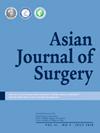Number of pits and affected area dimensions as predictors of recurrence in pilonidal sinus treated with phenol
IF 3.8
3区 医学
Q1 SURGERY
引用次数: 0
Abstract
Background
Pilonidal sinus is a chronic suppurative disease beneath the skin in the sacrococcygeal region. Minimally invasive techniques have gained popularity in recent years. This study investigates the impact of lateral pit presence, number of pits, length of affected area and width of affected area on treatment success as factors contributing to failure.
Methods
Data from 112 patients treated with phenol treatment between April 2021 and July 2022 were analyzed retrospectively. A total of 94 patients were included and followed up.
Results
The recurrence rate was 27.2 % in the group with three or more pits, while it was 8.19 % in the group with fewer than three pits. When the width of the affected area is less than 1.5 cm, the recurrence rate is 2.3 %, whereas when it exceeds 1.5 cm, the recurrence rate increases to 25 %. Similarly, when the length of the affected area is less than 2.5 cm, the recurrence rate is 8.3 %, but when it exceeds 2.5 cm, the recurrence rate rises to 17.1 %.
Conclusion
Our data indicate that the effectiveness of phenol treatment decreases in the presence of a width exceeding 1.5 cm, a length exceeding 2.5 cm and the presence of more than 3 pits.
苯酚治疗后毛毛窦的凹穴数目及影响区域大小与复发的关系
背景:毛突窦是骶尾骨区皮下的一种慢性化脓性疾病。近年来,微创技术得到了广泛的应用。本研究探讨了侧坑的存在、坑的数量、影响区域的长度和影响区域的宽度对治疗成功的影响,作为导致失败的因素。方法回顾性分析2021年4月至2022年7月112例接受苯酚治疗的患者的资料。共纳入94例患者并进行随访。结果3个及以上窝窝组复发率为27.2%,少于3个窝窝组复发率为8.19%。当患处宽度小于1.5 cm时,复发率为2.3%,而当患处宽度大于1.5 cm时,复发率增加到25%。同样,当患处长度小于2.5 cm时,复发率为8.3%,而当患处长度超过2.5 cm时,复发率上升至17.1%。结论我们的数据表明,在宽度超过1.5 cm,长度超过2.5 cm和存在3个以上凹坑时,苯酚处理的有效性下降。
本文章由计算机程序翻译,如有差异,请以英文原文为准。
求助全文
约1分钟内获得全文
求助全文
来源期刊

Asian Journal of Surgery
医学-外科
CiteScore
3.60
自引率
31.40%
发文量
1589
审稿时长
33 days
期刊介绍:
Asian Journal of Surgery, launched in 1978, is the official peer-reviewed open access journal of the Asian Surgical Association, the Taiwan Robotic Surgery Association, and the Taiwan Society of Coloproctology. The Journal is published monthly by Elsevier and is indexed in SCIE, Medline, ScienceDirect, Scopus, Embase, Current Contents, PubMed, Current Abstracts, BioEngineering Abstracts, SIIC Data Bases, CAB Abstracts, and CAB Health.
ASJSUR has a growing reputation as an important medium for the dissemination of cutting-edge developments in surgery and its related disciplines in the Asia-Pacific region and beyond. Studies on state-of-the-art surgical innovations across the entire spectrum of clinical and experimental surgery are particularly welcome.
The journal publishes original articles, review articles, and case reports that are of exceptional and unique importance. The journal publishes original articles, review articles, and case reports that are of exceptional and unique importance.
 求助内容:
求助内容: 应助结果提醒方式:
应助结果提醒方式:


